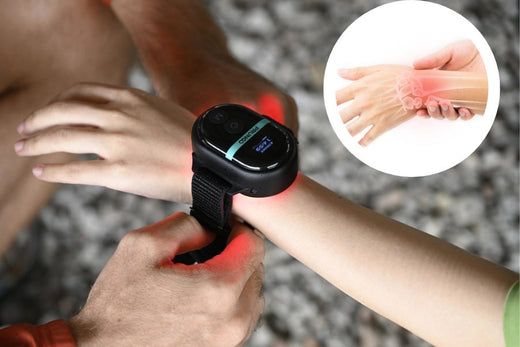Surgery is rarely needed for wrist tendonitis, as most individuals find relief through non-invasive treatments such as rest, ice, and physical therapy. However, if the condition becomes persistent and severely limits wrist movement, surgery might be the only remaining option.
In this article, we'll explain when surgery might be required for wrist tendonitis, the benefits and risks associated with it, and how other treatment options, including therapies like red light therapy, can offer effective alternatives to surgery.
What is Wrist Tendonitis?

Wrist tendonitis is an inflammation of the tendons in the wrist, typically caused by overuse or repetitive motion. The tendons connect muscles to bones, and when they become irritated or inflamed, they can cause pain, swelling, and stiffness.
This condition often affects the tendons involved in gripping, lifting, or rotating motions. The most common forms are De Quervain's tenosynovitis and flexor tendinitis. These conditions make everyday activities like writing, typing, or using a smartphone painful. To speed up recovery, consider using the strongest red light therapy at home to promote healing and reduce inflammation.
What Causes Wrist Tendonitis?
Wrist tendonitis is typically caused by repetitive movements that strain the tendons. Common causes include:
- Overuse: Repeatedly performing actions like typing, lifting, or twisting motions.
- Injury: A direct blow or sudden trauma to the wrist.
- Age: As we age, the tendons become less elastic, making them more prone to inflammation.
- Poor Ergonomics: Incorrect wrist positioning during tasks can increase strain.
- Sports: Activities that involve repetitive motions, like tennis or golf, can trigger wrist tendonitis.
Who is Susceptible to Wrist Tendonitis?

Certain individuals are more at risk of developing wrist tendonitis, including:
- Office Workers: Long hours of typing or using a mouse can strain the wrist.
- Athletes: Sports like tennis, golf, or swimming that involve repetitive wrist motion can lead to tendonitis.
- Manual Laborers: Those who engage in physical tasks such as construction, carpentry, or lifting heavy objects may be at risk.
- Older Adults: Age-related changes in the tendons can make them more vulnerable to inflammation.
Is Surgery Needed for Wrist Tendonitis?

In most cases, surgery is not necessary for wrist tendonitis. Regular treatments such as rest, ice therapy, medication, and physical therapy often provide effective relief.
Surgery is typically considered only when:
- Other Treatments Fail: When more conservative options don't work after several months.
- Severe Cases: If tendon damage is significant or the tendon ruptures.
- Chronic Pain: If the condition becomes chronic and severely limits wrist function.
If non-surgical treatments have not relieved your symptoms, surgery may be needed to repair or remove damaged tissue or correct structural issues.
Benefits and Risks of Surgery
While surgery can be effective for severe or chronic tendonitis, it comes with potential benefits and risks. Here are a few benefits of surgery:
- Pain Relief: Surgery may resolve chronic pain that doesn't improve with other treatments.
- Restoration of Function: For severe tendon damage, surgery can restore wrist function and mobility.
-
Long-Term Solution: If conservative treatments fail, surgery can offer a lasting solution.
Here are a few risks associated with surgery:
- Infection: As with any surgery, there's a risk of infection at the incision site.
- Nerve Damage: Surgery on the wrist can inadvertently damage surrounding nerves.
- Long Recovery Time: Recovery from wrist tendonitis surgery can take several months, during which physical therapy and rehabilitation are often required.
-
Scarring: Surgery may leave scars that could affect wrist movement or appearance.
Before opting for surgery, it's essential to weigh these benefits and risks with your healthcare provider.
Alternative and Complementary Treatments
If surgery is not necessary, or you want to explore less invasive treatments, several alternatives may provide relief and complement your recovery. Here are a few of them:
1. Acupuncture

Acupuncture has been used for centuries to reduce pain and inflammation. Stimulating specific points in the body can help release tension in the tendons and improve circulation to the affected area.
2. Massage Therapy
Massage therapy helps release muscle tightness around the wrist, reducing strain on the tendons. Techniques such as deep tissue massage or myofascial release can promote healing by improving blood flow and relaxing the muscles.
3. Ergonomic Adjustments
For those with repetitive stress injuries, ergonomic adjustments to the workstation are essential. Ensuring that your wrist is in a neutral position and using tools designed to reduce strain can prevent further aggravation of the condition.
4. Medical-grade Red Light Therapy Devices

medical-grade red light therapy devices, like Prungo's advanced devices, have become a popular and non-invasive treatment for tendonitis. It works by using low-level light to stimulate cellular activity in the affected area.
This helps reduce inflammation, promote healing, and relieve pain. Red light therapy has been proven to enhance tissue repair and reduce recovery time significantly, making it an ideal complementary treatment for wrist tendonitis.
How Prungo's Technology Helps
Prungo's red light therapy devices are designed for home use, offering a safe and effective way to accelerate healing without the need for invasive treatments. Their advanced technology utilizes targeted wavelengths to stimulate healing on a cellular level. By incorporating Prungo's devices into your routine, you can experience reduced inflammation, pain relief, and enhanced tissue regeneration—all from the comfort of your home.

Conclusion
Wrist tendonitis can be a painful and frustrating condition, but surgery is typically not the first line of treatment. In most cases, rest, physical therapy, and alternative therapies like red light therapy can provide relief. Surgery is only considered when other treatments fail, or if there is significant tendon damage.
If you're dealing with wrist tendonitis, consider exploring non-invasive treatments like Prungo's red light therapy devices. Their advanced technology helps accelerate healing and relieve pain, offering a safer and more effective solution to complement your recovery. To understand how red light therapy can help alleviate pain, check out how red light therapy works for pain relief.
FAQ

Can Wrist Tendonitis Heal Without Treatment?
In many cases, wrist tendonitis can heal with rest, ice, and over-the-counter anti-inflammatory medications. However, if symptoms persist, physical therapy or other interventions may be needed.
How Long Does It Take to Recover After Surgery for Wrist Tendonitis?
Recovery time can vary depending on the severity of the condition and the type of surgery performed. Generally, it can take several months to fully recover, including rehabilitation.
Is There a Risk of Recurrence After Surgery?
While surgery can repair tendon damage, there's always a risk of recurrence, especially if the underlying cause of the tendonitis is not addressed. It's crucial to follow rehabilitation recommendations and prevent further strain on the wrist.
How Soon After Surgery for Wrist Tendonitis Can I Use Red Light Therapy?
After surgery, it's important to consult your healthcare provider before starting red light therapy. Generally, light therapy can be safely used once the wound has healed and the risk of infection has passed, which may take a few weeks. To learn more about the timing, check out how soon after surgery can you use red light therapy.
















Share:
Red Light Therapy vs Infrared Sauna: A Comparative Analysis
How Can I Heal My Biceps Tendinitis Faster?